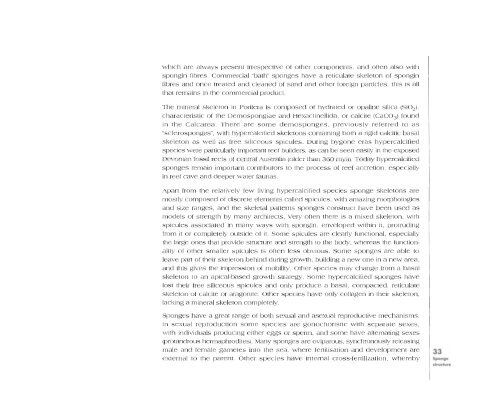Sponges of the New Caledonian lagoon - IRD
Sponges of the New Caledonian lagoon - IRD
Sponges of the New Caledonian lagoon - IRD
You also want an ePaper? Increase the reach of your titles
YUMPU automatically turns print PDFs into web optimized ePapers that Google loves.
whiCh are always present irrespective <strong>of</strong> o<strong>the</strong>r components, and <strong>of</strong>ten also with<br />
spongin fibres. Commercial "bath" sponges have a reticulate skeleton <strong>of</strong> spongin<br />
fibres and once treated and cleaned <strong>of</strong> sand and o<strong>the</strong>r foreign particles, this is all<br />
that remains in <strong>the</strong> commercial product.<br />
The mineral skeleton in Porifera is composed <strong>of</strong> hydrated or opaline silica (Si0 2 ),<br />
characteristic <strong>of</strong> <strong>the</strong> Demospongiae and Hexactinellida, or calcite (CaC0 3 ) found<br />
in <strong>the</strong> Calcarea. There are some demosponges, previously referred to as<br />
"sclerosponges", with hypercalcified skeletons containing both a rigid calcitic basal<br />
skeleton as well as free siliceous spicules. During bygone eras hypercalcified<br />
species were particularly important reef builders, as can be seen easily in <strong>the</strong> exposed<br />
Devonian fossil reefs <strong>of</strong> central Australia (older than 360 mya). Today hypercalcified<br />
sponges remain important contributors to <strong>the</strong> process <strong>of</strong> reef accretion, especially<br />
in reef cave and deeper water faunas.<br />
Apart from <strong>the</strong> relatively few living hypercalcified species sponge skeletons are<br />
mostly composed <strong>of</strong> discrete elements called spicules, with amazing morphologies<br />
and size ranges, and <strong>the</strong> skeletal patterns sponges construct have been used as<br />
models <strong>of</strong> strength by many architects. Very <strong>of</strong>ten <strong>the</strong>re is a mixed skeleton, with<br />
spicules associated in many ways with spongin, enveloped within it, protruding<br />
from it or completely outside <strong>of</strong> it. Some spicules are clearly functional, especially<br />
<strong>the</strong> large ones that provide structure and strength to <strong>the</strong> body, whereas <strong>the</strong> functionality<br />
<strong>of</strong> o<strong>the</strong>r smaller spicules is <strong>of</strong>ten less obvious. Some sponges are able to<br />
leave part <strong>of</strong> <strong>the</strong>ir skeleton behind during growth, bUilding a new one in a new area,<br />
and this gives <strong>the</strong> impression <strong>of</strong> mobility. O<strong>the</strong>r species may change from a basal<br />
skeleton to an apical-based growth strategy. Some hypercalcified sponges have<br />
lost <strong>the</strong>ir free siliceous spicules and only produce a basal, compacted, reticulate<br />
skeleton <strong>of</strong> calcite or aragonite. O<strong>the</strong>r species have only collagen in <strong>the</strong>ir skeleton,<br />
lacking a mineral skeleton completely.<br />
<strong>Sponges</strong> have a great range <strong>of</strong> both sexual and asexual reproductive mechanisms.<br />
In sexual reproduction some species are gonochoristic with separate sexes,<br />
with individuals producing ei<strong>the</strong>r eggs or sperm, and some have alternating sexes<br />
(protandrous hermaphrodites). Many sponges are OViparous, synchronously releasing<br />
male and female gametes into <strong>the</strong> sea, where fertilisation and development are<br />
external to <strong>the</strong> parent. O<strong>the</strong>r species have internal cross-fertilization, whereby<br />
33<br />
Sponge<br />
structure

















